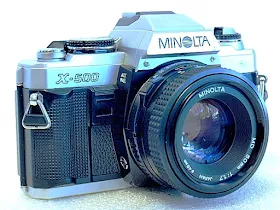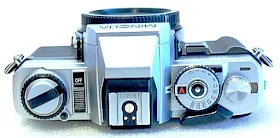The Vintage Enthusiast: An often overlooked manual focus autoexposure 35mm SLR film camera from Minolta with advanced user features.
Often overlooked by photo enthusiasts who were overawed by the capability of the X-700, the lower-priced X-500 may be a better camera for those who prefer to shoot in aperture priority or in full manual mode. The Minolta X-500 (X-570 in the US), introduced in 1983, a couple of years after the top-of-the-line X-700, is one and it came without the renowned 'MPS' capability of the X-700.
What it came with, however, are improvements in the development of the X-series electronics in the intervening years between the model's production runs. This includes a match LED exposure meter and the addition of a shutter speed LED display that blinks when the camera is in manual mode (features not available on the X-700), which otherwise is constant when the camera is used in AE.
The X-500 also saw the camera's flash synch system where the shutter speed of the camera can be set lower than the camera sync speed by activating the AE lock. With this technique, images can be captured with a shutter speed sufficient to accentuate details of the background, while the foreground retains its perfect exposure through the use of the flash.
The X-500 also records the correct light meter reading in DoF preview mode and displays the 'A' icon for aperture priority when a PX series flash is connected and switched to TTL mode.
The Minolta x570 in Action
Digital cameras are pretty great in today's day and age, but I strongly believe that film shouldn't be put on the back burner. Film photography is still to this day a valuable and useful medium to capture images, freeze time, and create memories. Music track can be found here: https://soundcloud.com/ryan-lheureux/the-valley-to-triumph Thanks to Celsey for filming.
Though seemingly small, these and other advances and refinements make for a more user-friendly camera, which adds to its value as a robust and intuitive tool to use. The X-500 is definitely the better choice for someone who already has knowledge of basic photography and is looking for an affordable, lightweight, fun, and easy-to-use 35mm SLR film camera.
Design and Built
The Minolta X-500 (X-570 in the US) is an Aperture-Priority AE 35mm SLR film camera with a quartz-controlled horizontal-traverse focal-plane shutter capable of a speed range from 4 seconds to 1/1000 second, B. The X-500 can also operate in a fully manual mode at pre-set shutter speeds (1 to 1/1000 second) with matched LED metering. Flash synchronization is at 1/60 second.
The standard focusing screen is Fresnel-field with horizontal split-image/microprism rangefinder with 95% screen coverage, metering is TTL (Through the Lens) center-weighted average, and film ISO speed range is from 12 to 3200. The camera is also equipped with a switch-selectable 10-second delay self-timer and an AE lock switch.
Camera operation is switch-controlled, the shutter release is two-step electromagnetic, and camera operation, and metering requires a pair of 2xSR44 LR44 button cells for operation. The camera's body weight is 490 grams without a lens or battery.
Basic Camera Features
The X-500 (X-570 in the US), available both in black and chrome, is built on the same chassis as the rest of the SR mount X-series and lacks only the fully automatic Program exposure mode of the X-700. Still a handsome lass nevertheless.
The front plane of the camera is a plain affair with only the DoF (Depth of Field) preview button abutting the lens mount housing on the lower right, The sync terminal and lens release button are located slightly above the right vertical of the lens mount housing. On the left of the front plane are the finger grip, the electronic self-timer, and the AE lock/self-timer switch set.
On the far left of the top plate is the film rewind crank, which is also the pull-up film back latch, and is integrated with button locked film ISO speed dial. Next to it is the slide Off / On / On-with-beep-sound camera power switch. A hot shoe sits on top of the pentaprism.
On the right of the pentaprism is the Auto-mode / shutter speed dial with a small release button to release the dial from the 'A' mode setting. The film advance crank, frame counter window, and film safe-load indicator are clustered towards the right of the top plate.
The back of the camera is plain except for the viewfinder eyepiece, sculptured finger grip, and the film tab holder located in the middle of the interchangeable hinge-type film back.
On the bottom plate of the X-500 are the film rewind release, battery chamber cover, tripod socket, motor drive coupling, winder guide slots, and electrical contacts.
The film box is a standard film cartridge chamber, shutter window, film advance sprocket, and multi-pin take-up spool. Film loading is the standard 2-blank shots to forward the film to frame 1. The Film Safe Load indicator will show a red indicator if the film is properly loaded.
Viewfinder Readout
The viewfinder readout of the X-500 (X-570 in the US) is a simple display of A and M shooting modes and a shutter speed scale, and B is located vertically on the right of the Acute Matte 95% coverage focusing screen with a central split focusing spot and microprism band, and a direct aperture readout window central on the lower frame.
The 'A' or 'M' shooting modes display are lined vertically on top of the shutter speed scale, metered or manually set shutter speeds are indicated by red or blinking red LEDs next to the numerical, and speeds are in between when two LEDs are lighted. Over- and under-exposures are indicated by LED arrowheads, and a flash-ready icon makes up the display.
Aperture Priority and Fully Manual Exposures
Getting the best out of aperture priority and fully manual shooting modes are the ways to get the best out of your film photography experience. With the X-500, which has an excellent metering system that gives you fantastic exposures with its AE mode, match needle metering in manual mode is equally effortless and convenient.
In manual mode operation, which can be done in shutter-priority style, you first set the shutter speed to the speed you want to shoot in,d after framing and focusing the image or composition, adjust the aperture of the lens to bring the metered speed LED indicator to match the blinking LED which indicates the shutter speed the camera was set to.
Doing manual mode in aperture priority means that you first pre-set the aperture opening of the lens to the one you want to shoot in and adjust the shutter speed setting to get to the correct exposure setting. The X-500 is equally up to the task here as the shutter speed selector dial is located very conveniently just forward of the shutter release button, and its operation is easily handled with the index finger.
Stop-down Metering
Unlike the X-700, which shows an incorrect exposure reading when using the DoF (depth of field) preview, the X-500 takes this action in its stride and does a full-through-the-lens exposure measurement instead.
This will still result in the correct exposure measurement even when using lens or lens peripherals that do not hook up to the metering system of the camera.
AE Lock
AE locking on the X-500 (X-570 in the US), usable only in 'A' mode, is a two-fingered operation. Exposure measurement is taken off a smaller rectangular area of the image frame.
Use your middle finger to press and activate the AE lock button to retain the exposure reading of your subject, and the other (the index finger) to release the shutter after you have reframed the image.
This method compensates for the unavailability of exposure compensation, which is not provided on the X-500. This technique is easy enough to master, and you will get used to this soon enough.
Battery
The X-500 uses a pair of SR44 or LR44 button cells, a very convenient source are they are easily available.
Camera Body Weight
The X-570 has a body weight of 480 grams without batteries.
Using The Camera
Ultimately, the X-500 (X-570 in the US) is a definite yes for film photography enthusiasts or for someone who already has a basic knowledge of film photography and wants a very capable and intuitive system to adapt to.
Couple this with a very bright and easy-to-use full information viewfinder, a very well-engineered system, and adaptability to an extended system of interchangeable parts and peripherals, and you are all set to go.<//p>















I have two of them, beside my XE. In addition to the inner Advantages over the X700 they mostly made Chrome Versions. That looks more classic than the black (professionel) X700. :D
ReplyDeleteHi, do you think you could help me with the iso-indication on the left on top of the camera? My window has gone invisible over the years and I would like to know what the intervals are between steps. So how many steps should I turn left from 400 to 100 (or preferably 125)?
DeleteThe click stops for the ISO setting are:
Delete12 • • 25 • • 50 • • 100 • • 200 • • 400 • • 800 • • 1600 • • 3200
Moving down from 400 to 125 will means 5 clicks (which are very sensitive on the unit I am testing) down.
Hope this helps, thanks.